Program Information
An Algorithm for the Reconstruction of An Entrance Beam Fluence Using a Simulated Exit Phantom Fluence
N Sperling*, E Parsai, University of Toledo Medical Center, Toledo, OH
SU-E-T-195 Sunday 3:00PM - 6:00PM Room: Exhibit HallPurpose: To design and test an algorithm for reconstructing entrance fluence from an exit fluence through a cylindrical phantom using fluence kernels generated in the BEAMnrc monte carlo code. This work may be extended to replace the simulated fluence with direct measurements on an EPID where dosimetry data from treatment can be acquired and compared with direct measures of fluence from devices used commonly for IMRT verification.
Method and Materials: A parameter space array of monte carlo fluence kernels is calculated for each voxel in a 256x256 pixel grid measuring across 16.384cm2 at 60cm SPD, which corresponds to a 40.96cm2 imager at 150cm SPD. An array of coefficients of parameter space elements is then used to calculate a fluence at 150cm SPD, and an iterative minimization solver is configured to minimize the sum of the square of the differences between the calculated fluence and the measured fluence.
Results: Comparison between two IMRT beam sequences simulated using the same BEAMnrc model used to generate the parameter space array were performed. The iterative solver was allowed to run for 15 minutes on a 128 core cluster on each phase space generated. A comparison of directly simulated entrance fluence and entrance fluence calculated by the proposed algorithm was performed, with a comparison criterion of the percentage of points in the fluence array with a threshold of 10% of maximum intensity, within 1% of the simulated fluence intensity; passing rates of 94.5% and 97.9% were achieved.
Conclusion: These results demonstrate that the algorithm is capable of reconstructing entrance fluence from simulated exit fluence within a reasonable tolerance for verification of delivery. Additionally, patient and beam specific parameter space arrays may be generated, allowing live measurements during treatment to be used for the reconstruction of entrance fluence with a high degree of accuracy.
Contact Email:


